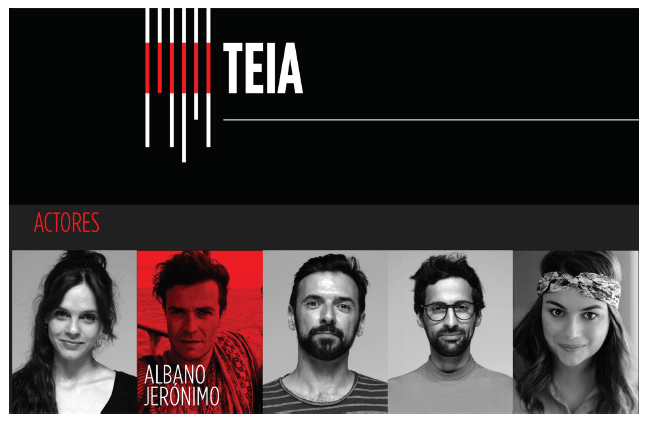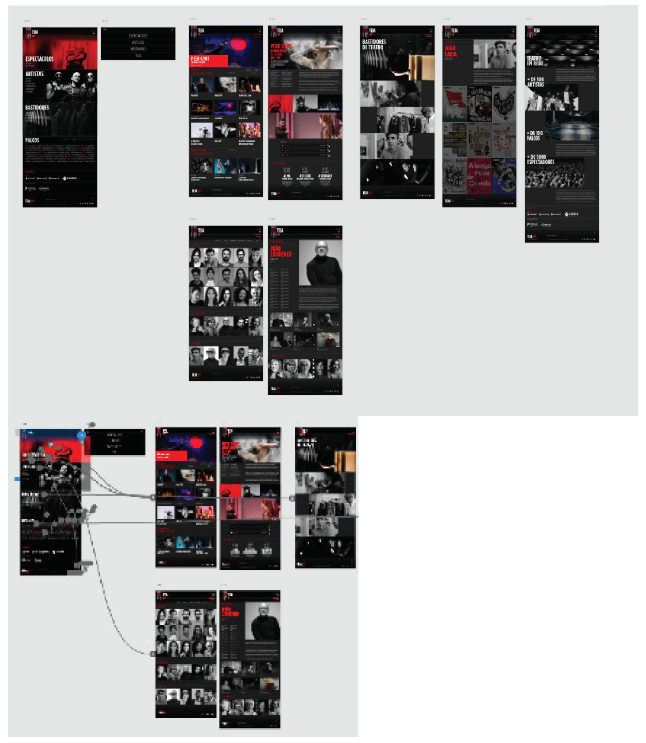1. Introduction
This study addresses the conception of a project carried out in 2020, under the discipline of Design Project of the PhD in Design at the Faculty of Architecture of the University of Lisbon, which results in a prototype of a digital platform (website) for exclusive contents of Theatre, entitled "Teia", as a consequence of a problem that emerged with the COVID 19 pandemic and in order to find a long-term solution for the term for the theatre culture.
For its realization a proper methodology was defined through the organization of contents, visualization of the concept, creation of layout and wireframes, resulting in the creation of a conceptual model and application of some animations to the model. We seek to create a differentiating identity from other digital platforms focusing on a contemporary and theatrical language.
With this article we intend to contextualize the relevance of the existence of a digital design project for theatre contents, narrating its creation (objectives and purpose), the definition of the process and methodologies applied in the various stages of its construction, addressing the development of the site structure, as well as the graphic and functional options.
2. Contextualization
A European Union study conducted in 2016, entitled "Culture Statistics", which presents a set of indicators for culture, concluded that 56% of the Portuguese attend live performances such as concerts, theatre shows, opera or dance is one of the cultural activities that most interest the Portuguese (Eurostat, 2016).
In 2017, the National Statistics Institute, in its annual survey on Live Shows, records that in that year there were 33 404 sessions of shows, with a total of 15.4 million spectators, and that within the shows, theatre was the modality with the highest number of sessions (38.6%) (INE, 2017).
The COVID-19 pandemic, which had its onset in Portugal in March 2020, paralysed the activities associated with culture. Numerous theatres, cinemas and performance halls were forced to suspend all their programming and close their doors and as a consequence of this crisis, theatres and companies had to reinvent themselves.
The theatre, designed for a face-to-face matrix, was forced to develop new forms of interaction and delivery of content to audiences, and to conceive new hybrid cultural shows (face-to-face/remote) through digital platforms.
Many of the initiatives to expand access and cultural diffusion, implemented during the pandemic, brought a new perspective of the massification of access to culture and highlighted the growing need to rethink the offer of theatre.
The pandemic brought to light a set of weaknesses for which theatre designers were also unprepared. The role of the designer, as Papanek (1971) tells us, has a social action, it was immediately requested as a facilitator in communication for these newly created solutions.
But what remains after this crisis? What happens to all the booty that was partially shared with the masses? What theatre stories could be told and shown to the public in order to make this public/theatre relationship even more dynamic?
This project, resulting from an analysis of the problems emerging from this crisis, comes to bring a vision of transformation in the access to culture, in the construction of an idea that allows the transition between conventional theatre, the access to archive shows on platforms and the public's discovery of all the art and artists involved in a theatre production.
3. Goals
As goals, we defined that it would be fundamental to bear in mind for the development of the concept of this project:
collect, preserve and disseminate the cultural heritage associated with theatre performances;
promote public access (free and free of charge) to the stage arts and creative industries
activate and enrich the panorama of cultural and artistic offer by generating a new cultural offer extended in space and time;
build a cultural archive for the future;
foster the emergence of new show artistic creations and concepts taking advantage of digital media:
to create links between the contents and the form of the project that allow for an exploitation of the inputs as contributions to our doctoral research.
4. Method. Design Project
Having the contextualization as reference, the project developed in the scope of the Design Project discipline, entitled "Teia", consisted in the conception of a prototype for a digital platform (website) having as focus the aggregation of a set of exclusive theatre contents.
The platform includes not only the dissemination of shows, through the cultural theatre agenda, but also access to the permanent visualization of shows in archive. In parallel, it allows access to exclusive information from backstage, which the common public doesn't have access to and which shows the other side of the stages, the reserved access to stories about authors, actors, musicians, directors, playwrights, designers, technicians and all the artists who are involved in the productions and metier of this art.
Once the decision on the scope of the project was taken, research was carried out in order to gather information on the theme where we identified that most theatres resorted to the use of digital platforms in the form of dissemination of archive shows.
The identification of similar platforms, as well as the design models applied and respective functionalities, allowed us to proceed with the concept creation and development phases.
5. Project Creation and Development
Before the information architecture was designed, the possible contents to be addressed were listed, a fundamental scheme in the organization of contents and in the analysis of hypothetical logical links between the various screens required.
These studies gave rise to the low fidelity prototypes and then to the definition of a visual concept graphically represented by a series of elements that created a cohesive and transversal identity to all the pages of the website.
The organization of a dynamic digital content requires considerable planning (Lupton, 2015) which, after a careful analysis of the contents of this platform, was essential.
In this model four categories were contemplated: Shows, Artists, Backstage, Web. In the "Performances" section, we find a diversified agenda of theatre performances (on stage or available in archive). In the "Artists" section, we find a set of information about the theatre artists: authors, directors, playwrights, actors, designers (graphic, light and sound), set designers, costume designers, prop designers, among others. In the "Backstage" section, we access a set of information related to theatre backstage themes: conversations with the audience, rehearsals, set design, costumes, photographic productions and communication design for shows. Finally, the "Web" section contains more general information about the platform: concept, artists/ambassadors, associated theatres, and partners.
The use of a grid, as an ordering system, is a graphic expression recurrently used to aid mental organization because it allows the designer to conceive his work in an orderly, constructive, and future-oriented way (Muller-Brockmann, 1981), and so after defining and designing the structure of the site, we define the wireframes. These represent the skeleton of the website, contemplating the layout of pages, in a simple representation of low fidelity.
It is up to the designer the relationship between the choice of typography (body and scale), the arrangement of lines, the use of colour and photographic elements (Tschichold, 1928) and, therefore, in defining the concept, it was important, through the use of various graphic elements, to intensify the theatrical experience, an experience that depends on the complex relationship between the gaze and other sensory forms that we can create (Johnson, 2012).
We chose to have as background, an environment that reminds "stage" using shades of black.
We created an identity representative of the concept and purpose of this site; a symbol was created to which was added the name "Teia" illuminated by red and with the designation "Platform for the Divulgation of Exclusive Theatre Content".
Since the experience of theatre depends on the complex relationship between what we see and what we feel (Johnson, 2012), the impact created by the image, came to reinforce the dramatic character and so, we chose to add navigation effects to the images. Finally, we tested the links between pages and adjusted the interactivity applied.
6. Discussion
For Scher (1995), one of the objectives in the creation of a design object is that the public relates to it and understands it. Following the author idea, it was not intended that this platform would present a "fashionable" design but that it would ally to its objective of dissemination and preservation of the theatre culture, functionality through a differentiating identity and concept.
Since this is a digital platform, we focus on user-centered design and four principles listed by Norman (2020): understand the problem, the people and the system and create a design that allows interaction.
The methodology used throughout the project, allowed confronting the initial idea, the creation of a platform that would gather a set of digital theatre contents, with the need and the importance of the existence of a design object of this typology in the cultural environment, and the impact it would have both in the theatre, by the promotion of this art, and in the artistic teams, by the public recognition that would be given to their work.
7. Conclusions
In this study we present a solution, for the problem presented, being aware that the materialization of a project with this typology would demand an enormous planning and would imply the resource of multidisciplinary teams.
As Graça-Moura (2020) tells us, the extent and dimension of the changes underway constitute a unique opportunity to rethink everything: life, politics, economy and culture. Given the circumstances, it is expected that culture and theatre assume, in a very near future, new contours not only at the level of the production of its shows but also in the way it may aggregate new parallel cultural products. The creation of new offers, as proposed in this project, aggregating several exclusive contents, related to the production of shows, may allow in a free and massified way to create audiences and increase the levels of consumption and loyalty to the theatre, allowing in parallel to create an archive of the Portuguese cultural heritage.
Acknowledgements
My thanks to Facudade de Arquitetura da Universidade de Lisboa. I especially thank to Doctor Rafael Pozo from TGRAF - ISEC Lisboa, for his guidance and recommendations, to Theatro Aberto for the support and availability that greatly contributed to our proposal. This work was developed at course subject Projeto de Design, PHD in Design, Faculdade de Arquitetura da Universidade de Lisboa in 2020.


















